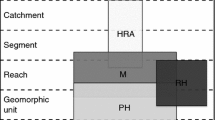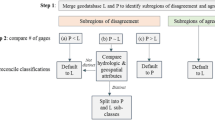Abstract
We describe the first test conducted to determine user consistency in the application of hydrogeomorphic (HGM) functional assessment models. Over a three-week period, two teams of individuals trained in the HGM methodology assessed 44 riverine wetlands on the Coastal Plain of Delaware, Maryland, and Virginia, USA. Results demonstrated a high degree of agreement between the two assessment teams for both Variable Subindices and Functional Capacity Index Scores, indicating that the assessment models were robust and results were repeatable. Analyses of the data demonstrated the importance of only using variables whose measurements are repeatable. When variable measurements are not repeatable, HGM functional capacity scores are detrimentally affected, especially functions that are modeled by only a few variables.
Similar content being viewed by others
Literature Cited
Ainslie, W. B., R. D. Smith, B. A. Pruitt, T. H. Roberts, E. J. Sparks, L. West, G. L. Godshalk, and M. V. Miller. 1999. A Regional Guidebook for Assessing the Functions of Low Gradient, Riverine Wetlands in Western Kentucky. Army Corps of Engineers, Waterways Experiment Station, Vicksburg, MS, USA. Technical Report WRP-DE-17.
Bedinger, M. S. 1979. Relation between forest species and flooding. p. 427–435.In P. E. Greeson, J. R. Clark, and J. E. Clark (eds.) Wetland Functions and Values: the State of Our Understanding. American Water Research Association, Minneapolis, MN, USA.
Brinson, M. M. and R. D. Rheinhardt. 1996. The role of reference wetlands in functional assessment and mitigation. Ecological Applications 6:69–76.
Brinson, M. M., W. Kruczynski, L. C. Lee, W. L. Nutter, R. D. Smith, and D. F. Whigham. 1994. Developing an approach for assessing the functions of wetlands. p. 615–624.In W. J. Mitsch (ed.) Global Wetlands: Old World and New. Elsevier Science B. V., Amsterdam, The Netherlands.
Brinson, M. M., F. R. Hauer, L. C. Lee, W. L. Nutter, R. D. Rheinhardt, R. D. Smith, and D. F. Whigham. 1995. Guidebook for Application of Hydrogeomorphic Assessments to Riverine Wetlands. Army Corps of Engineers, Waterways Experiment Station, Vicksburg, MS, USA. Technical Report TR-WRP-DE-11.
Brinson, M. M., R. D. Smith, D. F. Whigham, L. C. Lee, R. D. Rheinhardt, and W. L. Nutter. 1998. Progress in development of the hydrogeomorphic approach for assessing the functioning of wetlands. p. 383–406.In A. J. McComb and J. A. Davis (eds.). Wetlands for the Future. Gleneagles Publishing, Adelaide, Australia.
Brush, G., C. Lenk, and J. Smith. 1980. The natural forests of Maryland: an explanation of the vegetation map of Maryland. Ecological Monographs 50:77–92.
Federal Register. 1996. August 16, 1996. 61(160):42593–42603.
Federal Register. 1997. June 20, 1997. 62(114):33607–33620.
Gambrell, R. P. and W. H. Patrick. 1978. Chemical and microbiological properties of anaerobic soils and sediments. p. 375–423.In D. D. Hook and R. M. M. Crawford (eds.) Plant Life in Anaerobic Environments. Ann Arbor Science Publications, Inc., Ann Arbor, MI, USA.
Glascock, G. and S. Ware. 1979. Forests of small stream bottoms in the Peninsula of Virgina. Virginia Journal of Science 30:17–21.
Hupp, C. R., M. D. Woodside, and T. M. Yanosky. 1993. Sediment and trace element trapping in a forested wetland, Chickahominy River, Virginia. Wetlands 13:95–104.
Jones, R. H., B. G. Lockaby, and G. L. Somers. 1997. Effects of microtopography and disturbance on fine-root dynamics in wetland forests of low-order stream floodplains. American Midland Naturalist 136:57–71.
Mucller-Dombois, D. and H. Ellenberg. 1974. Aims and Methods of Vegetation Ecology. John Wiley and Sons. New York, NY, USA.
Parsons, S. E. and S. Ware. 1982. Edaphic factors and vegetation in Virginia Coastal Plain swamps. Butletin of the Torrey Botanical Club 109:365–370.
Piégay, H. 1997. Interactions between floodplain forests and overbank flows: data from three piedmont rivers of southeastern France. Global Ecology and Biogeography Letters 6:187–196.
Ponnamperuma, F. N. 1972. The chemistry of submerged soils. Advances in Agronomy 24:29–96.
Puckett, L. J., M. D. Woodsite, B. Libby, and M. R. Schening. 1993. Sinks for trace metals, nutrients, and sediments in wetlands of the Chickahominy River near Richmond, Virginia. Wetlands 13:105–114.
Rheinhardt, R. D., M. M. Brinson, and P. M. Farley, Applying wetland reference data to functional assessment, mitigation, and restoration. Wetlands 17:195–215.
Rheinhardt, R. R., D. Whigham, H. Kahn, and M. Brinson. In Press. Vegetation of headwater wetlands in the Inner Coastal Plain of Virginia and Maryland. Castanea.
Sánchez-Pérez, J.-M. and M. Trémolières. 1997. Variation in nutrient levels of the groundwater in the Upper Rhine alluvial forests as a consequence of hydrological regime and soil texture. Global Ecology and Biogeography Letter 6:211–217.
SAS Institute Inc. 1990. SAS Language: Reference. Version 6, First Edition. SAS Institute, Inc., Cary, NC, USA.
Smith, R. D., A. Ammann, C. Bartoldus, and M. M. Brinson. 1995. An Approach for Assessing Wetland Functions Using Hydrogeomorphic Classification, Reference Wetlands. and Functional Indices. U.S. Army Corps of Engineers, Waterways Experiment Station, Vicksburg, MS, USA. Technical Report TR-WRP-DE-10.
Strahler, A. N. 1957. Quantitative analysis of watershed geomorphology. American Geophysical Union Transactions 38:913–920.
Tiner, R. W. 1987. Mid-Atlantic Wetlands. A Disappearing Natural Treasure. Cooperative Publication, U.S. Fish and Wildlife Service, Region 5, Newton Corner, MA, USA, and U.S. Environmental Protection Agency, Region Three, Philadelphia, PA, USA.
Tiner, R. W. and D. G. Burke. 1995. Wetlands of Maryland. Cooperative Publication, U.S. Fish and Wildlife Service, Region 5, Hadley, MA, USA, and Maryland Department of Natural Resources, Annapolis, MD, USA.
Toner, M. and P. Keddy. 1997. River hydrology and riparian wetlands: a predictive model for ecological assembly. Ecological Applications 7:236–246.
Verhoeven, J. T. A., D. E. Whigham, K. Van Kerkhoven, J. O’Neill, and E. Maltby. 1994. Comparative study of nutrient-related processes in geographically separated wetlands: towards a science base for functional assessment procedures. p. 91–106.In W. J. Mitsch (ed.) Global Wetlands: Old World and New, Elsevier Science B.V., Amsterdam, The Netherlands.
Walbridge, M. R. and J. P. Struthers. 1993. Phosphorus retention in non-tidal palustrine forested wetlands of the Mid-Atlantic Region. Wetlands 13:84–94.
Wakeley, J. S. and R. D. Smith. In press. Verifying, field resting, and validating assessment models.In Hydrogeomorphic Approach to Assessing Wetland Functions: Guidelines for Developing Regional Guidebooks. Army Corps of Engineers. Waterways Experiment Station, Vicksburg, MS, USA.
Will, R. E., J. R. Seiler, P. P. Feret, and W. M. Aust. 1995. Effects of rhizosphere inundation on the growth and physiology of wet and dry-siteAcer rubrum (Red Maple) populations. American Midland Naturalist 134:127–139.
Zentner, J. 1999. HGM: A practitioner’s perspective. SWS Bulletin 16:25–26.
Author information
Authors and Affiliations
Rights and permissions
About this article
Cite this article
Whigham, D.F., Lee, L.C., Brinson, M.M. et al. Hydrogeomorphic (HGM) assessment—A test of user consistency. Wetlands 19, 560–569 (1999). https://doi.org/10.1007/BF03161693
Received:
Revised:
Accepted:
Issue Date:
DOI: https://doi.org/10.1007/BF03161693




